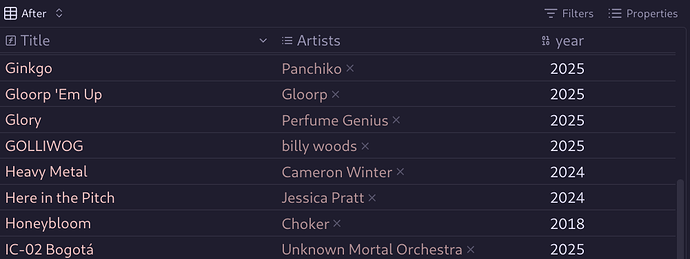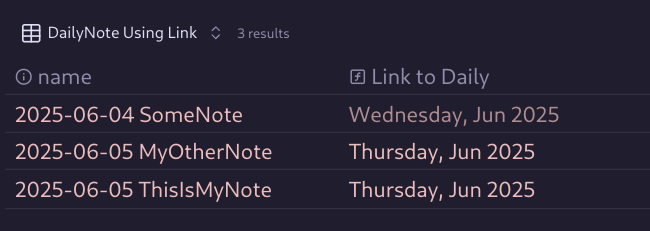Base functions have been changed pretty heavily in Obsidian 1.9.2. This should allow for more streamlined formulas, and should be a bit more intuitive, but there have been a lot of breaking changes as a result. I’ve put together a small guide to help ease the transition. This can also serve as a quick start guide for people new to Bases.
Here are some common formulas I’ve seen and how to implement them in with the new syntax:
Filtering by tag
#tagin the body of a note or a Property:- New:
file.hasTag("cat")file.hasTag("cat", "dog")file.hasTag("cat", "dog","",...)
- Old:
taggedWith(file.file, "cat")
- New:
tagonly in Properties- New:
tags.contains("cat") - Old:
contains(tags, "cat")
- New:
#taginline, not in properties
filters:
and:
- file.hasTag("cat")
- if(tags.contains("cat"), false, true)
Links
- General:
file.hasLink("path")
- Notes that link to
thisnote:- New
file.hasLink(this) - Old:
linksTo(file.file, this.file.name)
- New
- Property contains a link to
thisnote:- New:
- If your property is of type list:
<property>.contains(this) - If your property is of type text:
<property> == link(this)
- If your property is of type list:
- Old:
contains(<property>, concat("[[", this.file.name, "]]")) - Replace
<property>with the name of your property, i.e.director.contains(this),attendees.contains(this), etc.- If your property name has spaces or special characters, see note under Misc Notes
- If you have properties where the value is not in a list element, and is instead on the same line as the property key, you may need to convert your property to a list first:
list(<property>).contains(this)
- New:
Folders
- Filtering by folder
- New:
file.inFolder("MyFolder") - Old:
contains(file.path, "MyFolder")
- New:
- List all notes in the same folder as
thisnote:- New:
file.inFolder(this.file.folder) - Old:
contains(file.path, this.file.folder)
- New:
Created Today
- Using
ctime- New:
file.ctime.date() == today() - Old:
date(file.ctime) == date(now())
- New:
- Using a custom property in “YYYY-MM-DD” format
- New:
datecreated == today()(datecreatedbeing a date field) - Old:
datecreated == date(now())
- New:
Modified Today
- Using
mtime- New:
file.mtime.date() == today() - Old:
date(file.mtime) == date(now())
- New:
- Using a custom property in “YYYY-MM-DD” format
- New:
datemodified == today() - Old:
datemodified == date(now())
- New:
Created in the past n days
- Using
ctime, with n = 7- New:
file.ctime >= today() - "7d" - Old:
date(file.ctime) >= date(dateModify(date(now), "-7d"))
- New:
Modified in the past n days
- Using
mtime, with n = 7- New:
file.mtime >= today() - "7d" - Old:
date(file.mtime) >= date(dateModify(date(now), "-7d"))
- New:
Query all in note with a specific property
- All notes with a specific property which contains a value
myPropertyornote.myProperty
- All notes that contain a property, but it doesn’t have a value:
filters:
and:
- note.keys().contains("myProperty")
- !myProperty || myProperty == null
Misc Notes
- The
not()function has been removed, we can simply use!instead- New:
!director.contains(link("Hayao Miyazaki")) - Old:
not(contains(director, "[[Hayao Miyazaki]]"))
- New:
- If your property contains spaces or characters such as dashes, you’ll need to encode the property name like so:
- For
My Propertynote["My Property"]
- For
My-Propertynote["My-Property"]
- If you’re filling out a filter and select the property through the UI, this will be handled for you
- For
New
There’s also some new functions that have been added. Here are some examples of how you can implement them.
link()
This lets you set the display text for a link, similar to link aliases. This lets us use the value of a property as a link: link(file, property)
Example:
I have notes on albums, the note names are in this format: “GOLLIWOG-by-billy-woods-2025”
I have the following properties:
title: GOLLIWOG
artists:
- "[[billy woods]]"
year: 2025
I can create a Formula column with my formula set to link(file, title), and I’ll get a column that lists this note as “GOLLIWOG” instead of the full note title. I can hide my name column, and utilize this one instead to clean up my results.
Before:
After:
A more advanced use case for this function would be using it to create a link to a daily note using the note name:
- Suppose I have a note: “2025-06-05 My Note”
- I can add this formula in a column:
link(date(file.name.split(' ')[0]).format("YYYY-MM-DD"))- The exact implementation that will work for your vault will be dependent on your note name structure
- That column will now have a link to the corresponding daily note for that date
This gives us a lot of flexibility with creating link to notes within our base results. We can take this particular example a step further by using the display text parameter:
link(date(file.name.split(' ')[0]).format("YYYY-MM-DD"), date(file.name.split(' ')[0]).format("dddd, MMM YYYY"))
Using this, you can change the date format that is displayed for the daily note link.







